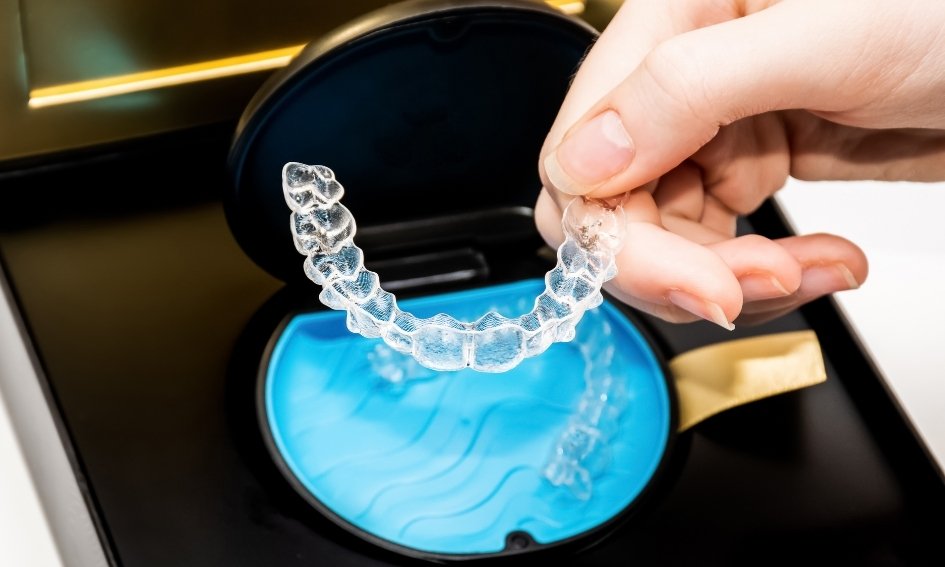Starting your Invisalign journey can be both exciting and nerve-racking. One of the first things many people ask is, “Is Invisalign painful?” The short answer: it can cause discomfort, especially during the first few days of each aligner set. However, the pain is usually mild and temporary. This blog breaks down what you can expect each week during the first month and beyond, so you feel more prepared and less anxious.
Let’s walk through it, week by week.
Week By Week – Invisalign Procedure
Week 1: Getting Used to the Pressure
This week tends to be the most uncomfortable. You’re introducing your teeth to pressure they’ve never felt before.
- Expect tightness in your teeth for the first 2–3 days.
- Mild soreness can occur when biting or chewing.
- You might develop slight irritation on your tongue or gums from the aligner edges.
- Talking may feel strange at first. A small lisp is common but usually fades quickly.
- You may feel tempted to remove the trays often — try not to. Keeping them in helps your mouth adjust faster.
To manage discomfort:
- Use orthodontic wax to reduce rubbing.
- Stick to soft foods like soups, mashed potatoes, and yogurt.
- Drink cold water — it helps numb the soreness naturally.
Pain will ease up after the first few days. Hang in there!
Week 2: Settling In and Less Soreness
By now, your mouth starts getting used to the aligners. You’ll feel far less pain compared to week one.
- Pressure on teeth becomes lighter and more manageable.
- Chewing may still feel off, but it won’t hurt as much.
- Any gum or tongue irritation usually fades by this point.
- You’ll notice your speech sounds more normal again.
This is when Invisalign in Houston starts to feel more like a habit than a hassle. Just remember to:
- Keep your aligners clean by brushing them gently.
- Avoid hot drinks while wearing them — they can warp the plastic.
- Continue wearing them for at least 22 hours a day.
Is Invisalign painful? At this point, not really. Any lingering soreness is minimal and often goes unnoticed.
Week 3: Time for a New Set
Just as you get comfortable, it’s time to switch to a new aligner tray. And yes, this can bring back some discomfort.
- Expect pressure again, though usually not as intense as week one.
- The discomfort lasts a day or two, not the entire week.
- Some people feel nothing at all with new trays, especially after a few cycles.
- If the trays feel too tight, try putting them in before bed so you sleep through the worst part.
Helpful habits during this week:
- Use a cold compress on your jaw if it aches.
- Stick to colder foods for the first 24 hours.
- Take over-the-counter pain relief if needed — but ask your Orthodontist first.
So, is Invisalign painful every time you switch trays? A little — but it’s nothing you can’t handle.
Week 4: Almost a Pro
At this point, most people feel little to no pain at all. Your mouth has adapted well, and switching trays becomes second nature.
- You may only notice a slight tightness after each new aligner.
- Chewing becomes easy again, even with aligners in.
- Most of the discomfort, if any, is just pressure, not pain.
- You’ll feel more confident wearing them throughout the day.
To keep your treatment on track:
- Stay consistent with wearing your trays.
- Avoid snacking too often — removing aligners repeatedly slows progress.
- Keep your case with you to store aligners safely when eating.
By now, you’ll likely answer “Is Invisalign painful?” with something like, “It was at first, but now it’s fine.”
What to Expect Beyond the First Month?
As the weeks go on, the adjustment period becomes easier. Each new tray brings less discomfort than the one before. That’s because your teeth have already begun moving and aligning.
What you may still feel:
- Occasional tightness during the first day of a new tray.
- Slight tenderness in certain teeth, often the ones moving most.
- Rare gum irritation if a tray doesn’t fit quite right.
What you likely won’t feel:
- Sharp pain.
- Long-lasting soreness.
- Trouble talking or eating for more than a few hours.
By month two or three, most people barely notice they’re wearing aligners. That’s one of the big reasons why so many choose this method over metal braces.
Quick Tips to Make Invisalign More Comfortable
A few simple habits can make your journey smoother:
- Switch trays before bedtime – this lets your mouth adjust overnight.
- Stay hydrated – dry mouth can make aligners more irritating.
- Use chewies – these help set your trays properly and reduce discomfort.
- Stick to the schedule – delaying tray changes can increase pain later.
And if you’re still wondering, is Invisalign painful? — Remember this: it’s usually mild and temporary. The benefits far outweigh a few days of pressure.
Invisalign isn’t pain-free, but it’s not unbearable either. Most people feel minor pressure and discomfort that goes away quickly. Staying consistent with wear time and care will help reduce soreness over time. Just like with anything new, the adjustment takes a little patience.
So if you’re considering clear aligners but worry about the pain, don’t stress too much. A little pressure means it’s working — and you’ll be smiling straighter in no time.

